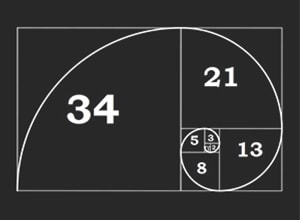The Fibonacci Strategy – the Basics
Gamblers have been trying to beat the game of roulette ever since it was first introduced at the end of the 18th century in France. These efforts, albeit futile, have birthed many staking systems that aim at helping players gain more profits at the roulette tables. The majority of systems are based on progressions, which is to say they call for adjustments in bet sizing depending on the results of previous spins.
One such strategy that is applicable to the game of roulette is based on one of the most easily recognisable number sequences in the world, that introduced by Italian mathematician Leonardo Pisano, better known as Fibonacci. The medieval mathematician came up with the sequence while he was trying to find a solution to a problem that involved the growth of rabbit population.
The solution was a mathematical sequence of numbers that describes the shape of most naturally occurring objects in the world, including the branching out of trees, the petals of flowers, and the intricate shape of conch shells. Another interesting example would be the length of the bones between the knuckles of one’s fingers. Each number of the sequence is equal to the sum of the two numbers preceding it.
- Up to $3000 welcome bonus upon first three deposits
- Well-established US-friendly brand
- Top quality casino games
- Extra bonuses for Bitcoin depositors
 ACCEPTED
ACCEPTED
PLAYERS FROM UNITED STATES: OHIO ARE ACCEPTED AT THIS CASINO
- Well-established brand
- Prompt payments
- 24/7 customer support
- Wide range of casino games
 ACCEPTED
ACCEPTED
PLAYERS FROM UNITED STATES: OHIO ARE ACCEPTED AT THIS CASINO
- Up to $300 bonus upon first three deposits
- Great loyalty program
- Superb loyalty program
- Great selection of table games
 ACCEPTED
ACCEPTED
PLAYERS FROM UNITED STATES: OHIO ARE ACCEPTED AT THIS CASINO
- Accepts players from all over the world
- Great daily bonuses
- Fair bonus rules and requirements
- Award-winning customer care team
 ACCEPTED
ACCEPTED
PLAYERS FROM UNITED STATES: OHIO ARE ACCEPTED AT THIS CASINO
The Fibonacci roulette system isn’t one of the most commonly used amongst professionals, and in my opinion certainly isn’t one of the best out there. That being said, there are advantages to this system over others and it is worth giving it a read to see if this style suits you.
The system uses the mathematical Fibonacci sequence, which goes as follows:
1 – 1 – 2 – 3 – 5 – 8 – 13 – 21 – 34 – 55 – 89 – 144 – 233 – 377 and so on as long as you want to go
It works by starting with 1, then adding the previous number in the sequence to get to the next number. In this system, each number represents a unit, and you can start anywhere you like, with the first number being the profit you will make at the end of the round. Clearly, starting with the first number 1 is the safest option with the least reward, and starting higher up in the sequence is riskier but provides a greater profit.
How the Fibonacci Roulette System Works
 The Fibonacci is similar to the Martingale since both rely on negative betting progressions. What this means is the player needs to increase their next bet after each loss and decrease it after each winning coup. The bet sizing is adjusted in accordance with the Fibonacci sequence, with each number representing the number of base betting units you need to stake.
The Fibonacci is similar to the Martingale since both rely on negative betting progressions. What this means is the player needs to increase their next bet after each loss and decrease it after each winning coup. The bet sizing is adjusted in accordance with the Fibonacci sequence, with each number representing the number of base betting units you need to stake.
The Fibonacci system is applicable to all bet types in the game of roulette but any experienced gambler will recommend you to use it on even-money bets only where the chances of winning a coup are 48.64% on a single-zero wheel and 47.36% at the American tables. If you are successful with one such bet, the house will double the money you have staked with a payout of 1:1. I am talking about bets on red/black, odd/even, and high/low. Applying the sequence on inside bets, especially those on individual numbers, is way too risky and may quickly lead to your financial demise.
The first thing you need to do is decide on what size your base betting unit should be. This decision should be coordinated with the size of the overall bank you have set aside for your roulette session. By general rule, experienced roulette mavens would recommend you to restrict your base unit’s size to roughly 1% to 2% of your total bank.
In all cases, it should not exceed 5% of your bankroll for the session. So if you start with a bank of $200, your base unit should be no more than $10 or 5% of your session’s money. Each of the numbers in the sequence corresponds to the number of units you need to stake following a loss or a win.
Let’s say you start at the first number in the sequence and bet $10. You place this bet, and if you win, the round is over with one-unit profit made so you bet one unit of $10 again. If you lose, you bet the second number in the sequence which corresponds to two units for a total of $20. Lose again and you skip to number three in the sequence by staking three units or $30.
You continue following the sequence until you eventually register another win, at which point you move back TWO numbers and use this as your new bet. To proceed with our example, you need to drop back to the very beginning of the sequence and bet a single unit of $10 again. But if you have won after staking say 21 units, you will be required to bet 8 units on the next coup. You continue to do this until you get back to where you started, and then bet this number as well. This final step is very important.
These are the rules you need to abide by – you increase your bet according to the sequence after a loss and drop two numbers back when you register a win. There are only two exceptions from the general rule, the first one applying to the instances when the player has failed to move up even with two numbers before registering a win, in which case they need to start with the first number of the sequence again.
Winning two bets in a row is critical when using the Fibonacci system. The second exception requires the player to go back to the beginning of the sequence as soon as they turn up any net profit during the betting cycle. This requirement is precisely what increases the level of complexity of the Fibonacci system as players need to keep a close track of the exact amounts they won and lost during the betting cycle.
This is crucial as it lets them know when they should end one betting cycle and commence a new one. This is not as difficult when you play at an online casino but if you join a landbased roulette table, you might need to use a pen and a spreadsheet to write down your win/loss results. Stay focused as otherwise, you risk messing up your entire sequence.
At this point, you might not be able to see the benefits of using this system, so let me show you a graphical example of how exactly the Fibonacci works. You can see it in the table below. *Note that I have used a base betting unit of $10 for simplicity’s sake.
| Coup | Number of Base Units* | Win/Loss | Profit in Base Units | Profit in $ |
|---|---|---|---|---|
| #1 | 1 | Loss 1 | -1 | $10 down |
| #2 | 1 | Loss 1 | -2 | $20 down |
| #3 | 2 | Loss 2 | -4 | $40 down |
| #4 | 3 | Loss 3 | -7 | $70 down |
| #5 | 5 | Loss 5 | -12 | $120 down |
| #6 | 8 | Win 8 | -4 | $40 down |
| #7 | 3 | Loss 3 | -7 | $70 down |
| #8 | 5 | Win 5 | -2 | $20 down |
| #9 | 2 | Win 2 | 0 | 0 |
| #10 | 1 | Win 1 | +1 | $10 |
Obviously, the idea behind the Fibonacci roulette system is that before long, players would eventually register a larger win due to the steep bet increase following losses and this single big win would make up for all the money they have lost. Before you jump into your vehicle and drive to the nearest casino to test the Fibonacci at the roulette tables, you need to take several critical things into consideration.
With the above-provided table, I have demonstrated what precisely happens when you suffer a longer string of losses. As you can see yourself, the fictional player from my example has successfully recouped their losses, emerging from the session with a net profit of precisely one base unit. Some players are not as lucky.
Because the negative progression is steep, things can get rather ugly after a streak of just five losing coups where the player is forced to bet as much as $80 on the sixth round despite being already $120 down. By now it has probably dawned on you things tend to get serious with the Fibonacci on longer losing strings of losses as the player is required to stake huge amounts of money just to break even or win one or two units in net profits.
What you need to think about is that a lengthy losing streak can see you fall into a hole which is very difficult to come back from. Sometimes you seem to just go further and further down the sequence and the idea of getting back to where you started from seems impossible. This is why this system requires patience, perseverance, and above all a more substantial bankroll, as you will often find yourself in this position. Remember, it is best to start small and steer clear from utilising larger base units with the Fibonacci.
Pros and Cons of the Fibonacci System
 While the Fibonacci system may prove to be effective over the short term, players who are just diving into the thrilling world of gambling should bear in mind the Fibonacci, like any other betting system, has both its pros and cons. Allow me to start with the advantages the system can offer to roulette players.
While the Fibonacci system may prove to be effective over the short term, players who are just diving into the thrilling world of gambling should bear in mind the Fibonacci, like any other betting system, has both its pros and cons. Allow me to start with the advantages the system can offer to roulette players.
One of the biggest gains of using this system is that it teaches players to join the roulette table with a clear plan in mind, a plan that above all has to do with money management. Thus, one adjusts their bets strategically instead of blindly throwing their money away. Playing strategically, of course, prevents you from making rash decisions and chasing your losses during a poor run.
Also, since the Fibonacci is, after all, based on a mathematical sequence, it is proven to work when it comes to generating small but consistent profits over the short term. Another great thing about this system is you can lose many more times than you win and still make a profit. This strategy can also be used with a relatively low bankroll, but you need to start at the beginning of the sequence and use a small base unit. For many, I am sure, this is a big bonus.
Equally though, you can alter the system to suit you and change how much you make each round. If you have a large bankroll then you can start further down the sequence, and still have a sensible strategy to recoup your losses and make a profit with more losses than wins.
But unfortunately, this is where the benefits of using this system end. Many gamblers rely on the Fibonacci because it is based on patterns that are to be found everywhere in nature. Therefore, they believe nature can provide them with the answers necessary to beat this game of chance.
While one such assumption is correct in a sense, it should be noted that any system, be it the Fibonacci, the Martingale or the Paroli, is powerless against the house edge and does not affect your odds of winning in any way. The odds of hitting black or red (or any other outcome for that matter) remain constant no matter what system is in play at the table. This is where system play falls flat – the only way to eliminate the house edge in this game of chance is by getting rid of the green zero pocket. Only then can you count on playing a game of even-chances.
One of the biggest downsides of the Fibonacci is that it requires quite the bankroll and may not be suitable for all players. Although it is less steep than the Martingale, bet sizes with the Fibonacci tend to still escalate at a rapid pace, especially later on in the sequence. In addition, players who adopt it may end up facing several serious issues especially during a long string of losses.
Anyone who has ever engaged in roulette knows that registering several consecutive losses with even-money bets is anything but impossible. This will cause you to progressively bet larger and larger amounts of money – quite a big problem especially if your bank is small, to begin with.
While using a betting strategy is allowed in most venues, there is one such thing as a table maximum and let me tell you these rules are enforced on purpose to hinder system players. If you suffer an excruciating losing streak (and a probability of this happening does exist), you may end up hitting the table limit, at which point you will be unable to proceed with your bet sequence according to plan. From this point on everything is futile. Even if you are lucky and win the coup, you will not offset all of your previous losses because you have not bet the needed number of base units to do so. To continue would be useless.
And what if you run out of money before your bad run has actually ended? You will most likely end up leaving the venue deprived of your illusions as well as of your bankroll. This is why the Fibonacci should be used with smaller base units but it still requires you to have a sufficient amount of money to be able to weather out losing streaks.
Now this situation can obviously happen with many systems, but it’s not so bad when the profit at the end of it is significant. If you are starting off with one unit, however, then 20 minutes each round for one unit can certainly make this system seem pointless. The thing about the Fibonacci is it does work, but only over the short term and the profits, it can earn you are normally far from awe-inspiring. As you have seen from the table above, it is more than likely for you to end your session with a meagre unit in profits. Which is better than losing everything but still is far from motivating.
Last but not least, let us not forget that increased complexity will be another thing a longer string of losing bets is likely to bring about. The more you progress through the sequence, the more complex the calculations you must perform should become as the numbers that need to be added up will be larger. The result is utter confusion for the inexperienced player. This on its own may lead to errors causing the entire session to go to waste. Because of this, some casual roulette players prefer to either memorise the first 15 or so numbers of the sequence by heart or better yet use a pen and paper while playing.
There is not an awful lot more to say about this system. It is not one I tend to use, but I did feel like it was worth a mention. It’s certainly got its benefits, in particular, it is safe (if you decide to play it that way), and versatile if you’re looking to get a bit more out of it. For me, though I just feel like there are better systems out there, such as the Labouchere roulette system, which can be more rewarding, faster paced, and not necessarily too risky. That being said, give it a try and let me know how you get on with it. I would love to hear your feedback so please leave any comments you have on this system below.






Hi AGAIN, have ghost bet this on ch5& I started at 3in the sequence, so result was:-3-5-8+13+5+2! With each win I, as you said moved 2digits back in the sequence & resulted in profit but WITHOUT arriving back at my starting point of 3.How come??